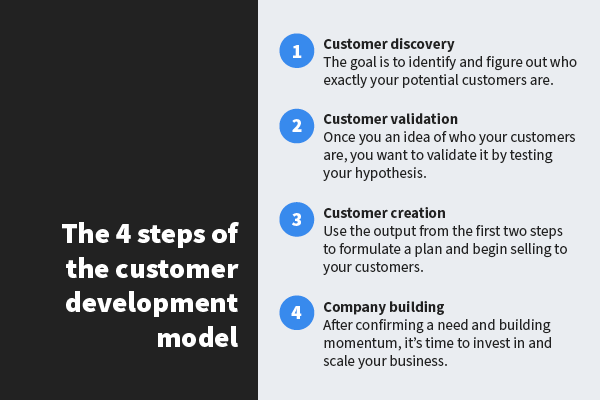Blog Highlights
- In the rush to get their product idea to the market, many established businesses and startups skip the due diligence needed to confirm that their product would actually be viable, potentially shoveling investment dollars behind a bad bet.
- The customer development model flips this concept on its head, outlining a method for putting the customer and their needs first. This not only confirms that a market exists, but it also provides a solid foundation for a long-term investment and fact-based decision-making.
- This model thrives on data, so organizations need a solution to seamlessly collect, organize, and analyze customer data for the long haul.
At their core, businesses offer a product or service that their customers keep coming back for. How organizations find that certain something that drives customers to their brand, however, can vary widely.
Some businesses begin with a spark of inspiration and then are fueled by marketing and word of mouth. Still, there are other approaches to identifying, understanding, and delivering a product that your customers queue up for. One method begins with directly listening to customers, discovering their needs, and connecting your product or service directly with their needs. This way of structuring your business is known as the customer development approach.
So just how different is the customer development approach from more traditional approaches, and how can your business benefit from this perspective?
What are the most important elements of the customer development model?
The customer development model is credited to Steve Blank, who wrote a book about his decades of experience as an entrepreneur in Silicon Valley, titled The Four Steps to the Epiphany.
After watching the rise and fall of many startups, Blank documented what he saw as the key qualities that companies in their early stages had to possess to have staying power. As Blank toured the country and began teaching entrepreneurship at the University of California, Berkeley; Columbia University; Stanford; and New York University, his principles formed the foundation of the Lean Startup movement.
Soon, organizations of all sizes realized that his model could benefit any team looking to design and launch a new product or service, emphasizing the need to find customers, define the market, and directly tie a product to the pain points identified. To facilitate this process, Blank introduced the customer development model to structure the key steps, add discipline to the process, and define expectations for internal stakeholders.
Unlike other approaches, the customer development model is not necessarily linear. Instead, it's a set of criteria, or “gates,” that a team should use to validate the strength of its product idea against the potential market. Similarly, the model is not about identifying specific requirements or marketing plans, but rather collecting a broad set of data to test ideas so those without support do not move forward. In other words, teams can move in and out of the different steps based on the information they're collecting until they feel confident that their product or concept is viable.
Step 1: Customer discovery
- Who are the real customers who would be interested in your product or service?
- What are the problems that they are facing?
- Which personas could you see using the product?
These are the types of questions that organizations should answer during the customer discovery phase, ultimately getting a full understanding of the problem that their product could solve. However, it’s not about the features or even beta testing of a prototype. It’s about getting out there — physically or virtually — and figuring out exactly who the potential customers are.
Step 2: Customer validation
With a rough idea of customer personas in place, this is the time when you can work to validate your understanding of the potential customers and how you can reach them. This can involve interviews, focus groups, questionnaires, and similar techniques to help you better understand your target audience.
Although you may have collected data pointing toward a gap that a number of customers have revealed, can you reach those customers and convince them to move to your solution? Are there enough of them to justify the investment?
If the answer is no, then you can go back to the discovery phase and start again or refine your results and continue with a new validation effort.
Step 3: Customer creation
Taking your outputs from the first two phases of the customer development model, you can then begin to formalize a plan to understand where your product fits within one of Blank’s four “startup markets.” These include:
- Pre-existing markets
- New markets
- Existing markets with space for low-cost alternatives
- Existing markets with space for new segments/niches
This step is important because it helps shape the overall market environment that your product will face after launch, preventing your team from investing in development, testing, and marketing when there isn’t space for a new product to be profitable.
This is also the phase in which you may begin to sell your product, collect feedback from early customers, and understand which marketing and sales channels are having the most success.
Step 4: Company building
Once you have confirmed a need for a new product and have built some early momentum in the market, you can ramp up your investment in development, production, and marketing to drive sales.
It’s important that the investment push and the scaling don’t happen until this stage, when you know there are a significant number of customers out there willing to buy your product. This will prevent you from overextending your investment too soon.
What are the benefits of the customer development model?
Although this may seem like a significant amount of internal research, discussion, and preparation and not enough action for some in today’s fast-paced global economy, the customer development model has several key benefits that make the extra effort worthwhile.
First, on the product side, it helps a company develop and deliver a product that is simpler at the outset so customers can directly see the value in it. This can be especially important for startups and small businesses that are looking to maximize their chances of success when investment dollars may be limited.
Second, the customer development model facilitates cross-functional collaboration and drives sweat equity across the organizational hierarchy. For example, the model provides a mechanism, and a need, for customer success staff, the marketing team, and sales managers to turn customer feedback into actionable insights. At the same time, executives can use facts taken directly from the research and customer feedback to drive their decisions, rather than relying on emotions or wishful thinking.
In the end, the model is there to help prevent companies from making the mistake of investing too many human and financial resources into a product or solution without truly testing whether it’s the best approach to meet customers’ needs.
What’s the next step?
If it’s properly applied, Blank believes that the customer development model should give businesses the information they need to feel confident not only that their product is viable, but also that it has a viable market. In other words, the customer development model should result in more products hitting the market with the right features that solve real problems for real customers.
Throughout all four steps of the customer development model — and the product development model that it complements — customer data is critical. CallRail’s comprehensive platform, which includes Call Tracking, Lead Center, Conversation Intelligence, and Form Tracking, can help you collect, organize, and analyze the data you need to fuel your product research and development.
And once a product hits the market, CallRail will be there to prioritize leads, streamline customer management, and refine marketing strategies to target those who offer the most value.
To learn more about all of CallRail’s solutions, contact us for a detailed demo or start your 14-day free trial.








